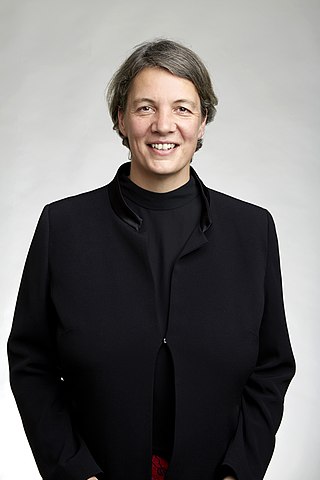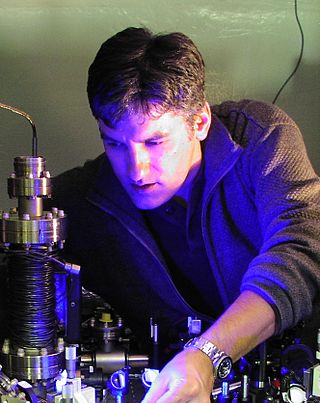Related Research Articles

Wilson da Silva is an Australian feature writer, science journalist, editor and documentary filmmaker who has worked in magazines, newswires, newspapers, television and online. He is a co-founder and the long-serving former editor of Cosmos, an Australian science magazine.

The Eureka Prizes are awarded annually by the Australian Museum, Sydney, to recognise individuals and organizations who have contributed to science and the understanding of science in Australia. They were founded in 1990 following a suggestion by science journalist Robyn Williams.
Charles Tahan is a U.S. physicist specializing in condensed matter physics and quantum information science and technology. He currently serves as the Assistant Director for Quantum Information Science (QIS) and the Director of the National Quantum Coordination Office (NQCO) within the White House Office of Science and Technology Policy. Tahan is also Chief Scientist of the National Security Agency's Laboratory for Physical Sciences.

David Jeffery Wineland is an American physicist at the Physical Measurement Laboratory of the National Institute of Standards and Technology (NIST). His most notable contributions include the laser cooling of trapped ions and the use of ions for quantum-computing operations. He received the 2012 Nobel Prize in Physics, jointly with Serge Haroche, for "ground-breaking experimental methods that enable measuring and manipulation of individual quantum systems."
Amanda Susan Barnard is an Australian theoretical physicist working in predicting the real world behavior of nanoparticles using analytical models and supercomputer simulations and applied machine learning. Barnard is a pioneer in the thermodynamic cartography of nanomaterials, creating nanoscale phase diagrams relevant to different environmental conditions, and relating these to structure/property maps. Her current research involves developing and applying statistical methods and machine/deep learning in nanoscience and nanotechnology, and materials and molecular informatics. In 2014 she became the first person in the southern hemisphere, and the first woman, to win the Feynman Prize in Nanotechnology, which she won for her work on diamond nanoparticles.

Michelle Yvonne Simmons is an Australian quantum physicist, recognised for her foundational contributions to the field of atomic electronics.

Tanya Mary Monro is an Australian physicist known for her work in photonics. She has been Australia's Chief Defence Scientist since 8 March 2019. Prior to that she was the Deputy Vice Chancellor, Research and Innovation (DVCR&I) at the University of South Australia. She was awarded the ARC Georgina Sweet Australian Laureate Fellowship in 2013. She was the inaugural director of the Institute for Photonics & Advanced Sensing (IPAS). Monro has remained an adjunct professor of physics at the University of Adelaide following her departure from the institution. In 2020 she was awarded the title of Emeritus Professor at the University of South Australia.

Christopher Roy Monroe is an American physicist and engineer in the areas of atomic, molecular, and optical physics and quantum information science, especially quantum computing. He directs one of the leading research and development efforts in ion trap quantum computing. Monroe is the Gilhuly Family Presidential Distinguished Professor of Electrical and Computer Engineering and Physics at Duke University and is College Park Professor of Physics at the University of Maryland and Fellow of the Joint Quantum Institute and Joint Center for Quantum Computer Science. He is also co-founder of IonQ, Inc.
Ping Koy Lam is an Australian scientist and Professor of Physics at the Australian National University in Canberra. He is currently an Australian Research Council Australian Laureate Fellow and a work package director and program manager in the ARC Centre for Quantum Computer and Communication Technology. For his PhD thesis in 1999 he was awarded the Australian Institute of Physics Bragg Medal. He was awarded the 2003 British Council Eureka Prize for inspiring science and the 2006 UNSW Eureka Prize for innovative research.

Gerard James Milburn is an Australian theoretical quantum physicist notable for his work on quantum feedback control, quantum measurements, quantum information, open quantum systems, and Linear optical quantum computing.
The Sydney Nanoscience Hub is a nanoscience facility of The University of Sydney Nano Institute at the University of Sydney in Camperdown, Sydney, Australia. The laboratories in the building are isolated from outside influences such as vibration, electromagnetic fluctuations, temperature and atmospheric pressure variation, the air in the laboratories is also filtered to be free of dust.
The University of Sydney Nano Institute is a multidisciplinary research institute at the University of Sydney in Camperdown, Sydney, Australia. It focuses on multidisciplinary research in nanoscale science and technology. It is one of ten multidisciplinary research institutes at the University of Sydney, along with the Charles Perkins Centre and the Brain and Mind Centre.

Andreas J. Heinrich is a physicist working with scanning tunneling microscopy, quantum technology, nanoscience, spin excitation spectroscopy, and precise atom manipulation. He worked for IBM Research in Almaden for 18 years, during which time he developed nanosecond scanning tunneling microscopy which provided an improvement in time resolution of 100,000 times, and combined x-ray absorption spectroscopy with spin excitation spectroscopy. In 2015 his team combined STM with electron spin resonance, which enables single-atom measurements on spins with nano-electronvolt precision REF1, REF2. In 2022 his team demonstrated the extension of ESR-STM to individual molecules REF3. Heinrich was also principal investigator of the stop-motion animated short film A Boy and His Atom filmed by moving thousands of individual atoms. He is a fellow of the American Physical Society and the American Association for the Advancement of Science and the recipient of the Heinrich Rohrer Medal of the Japan Society of Vacuum and Surface Science.
Simon John Devitt is an Australian theoretical quantum physicist who has worked on large-scale Quantum computing architectures, Quantum network systems design, Quantum programming development and Quantum error correction. In 2022 he was appointed as a member to Australia's National Quantum Advisory Committee.

Jared Cole is an Australian theoretical physicist specialising in quantum physics and decoherence theory and its application to solid-state systems. He specialises in using mathematical and computational models to describe the design and operation of quantum computing and quantum electronic devices.

Elanor H. Huntington is Executive Director of Digital, National Facilities & Collections at the Commonwealth Scientific and Industrial Research Organisation and a Professor of Quantum Cybernetics at the Australian National University. She led a research program in the Australian Research Council Centre of Excellence for Quantum Computation and Communication Technology.

The Center for Quantum Nanoscience was founded in 2017 as part of efforts for South Korea to expand basic science research. Classified as an Extramural Center of the Institute for Basic Science, it is hosted by Ewha Womans University in Seoul, South Korea. Their research focuses on exploring quantum properties of atoms and molecules on surfaces and interfaces and long-term goals of quantum sensing and quantum computation in those areas.

Andrea Morello is the Scientia Professor of Quantum Engineering in the School of Electrical Engineering and Telecommunications at the University of New South Wales, and a Program Manager at the ARC Centre of Excellence for Quantum Computation and Communication Technology (CQC2T). Morello is the head of the Fundamental Quantum Technologies Laboratory at UNSW.
Anita Ho-Baillie is an Australian scientist who is the John Hooke Chair of Nanoscience at the University of Sydney. Her research considers the development of durable perovskite solar cells and their integration into different applications. She was named as one of the Web of Science's most highly cited researchers in 2019–2022.
References
- ↑ "Professor Michael Biercuk". The University of Sydney.
- ↑ "Prof. Michael Biercuk". ARC Centre of Excellence for Engineered Quantum Systems.
- ↑ "Michael J. Biercuk". TEDxSydney.
- ↑ "Eureka moment for quantum computing". The Australian. 26 August 2015.
- ↑ "Young Physicist Awarded NMI Prize". The University of Sydney.
- ↑ "The Collector's View: WatchTalk with Michael Biercuk -". DEPLOYANT. 5 November 2018.
- ↑ "Australia's first facility built for nanoscience launched, world-leading". Special Broadcasting Service.
- ↑ Strom, Marcus (8 March 2016). "Sydney University to open Nanoscience Hub for the quantum technologies of the future". The Sydney Morning Herald.
- ↑ Strom, Marcus (3 May 2016). "US intelligence awards multimillion dollar grant to Sydney University quantum science lab". The Sydney Morning Herald.
- ↑ "Quantum start-up Q-Ctrl "unmixing the soup" of qubit decoherence". Computerworld.
- ↑ "Sequoia Capital backs Q-Ctrl, the Australian quantum computing start-up". Australian Financial Review. 9 July 2018.
- ↑ "Sequoia Capital backs Q-CTRL, the Australian quantum computing start-up". Australian Financial Review. 9 July 2018.
- ↑ "Aussie start-up Q-CTRL handpicked by IBM to join world-leading quantum network". Australian Financial Review. 5 April 2018.
- ↑ Koehn, Emma (4 December 2018). "Quantum leap: Sydney startup launches world-first software product". The Sydney Morning Herald.
- ↑ "Q-CTRL's Black Opal offers quantum leap in computing". The Australian.
- ↑ "Australia races towards commercial quantum computing". Computer Weekly.
- ↑ Palmer, Charis (2007). "Influential mentor wins overdue recognition with Nobel Prize in Physics". The Conversation.
- ↑ "Science gets measure of the tiny". The Australian. 4 September 2011.
- ↑ "Getting the measure of awards". The Australian. 5 September 2011.
- ↑ Rolfe, Dominic (29 November 2012). "Top 100: the thinkers". The Sydney Morning Herald.
- ↑ "10 experiments". BBC Focus. 9 November 2017. Archived from the original on 9 November 2017.
- ↑ "Eureka Prize for Associate Professor Michael J. Biercuk". The University of Sydney.
- ↑ "Eureka Prize honours quantum computing pioneers". ABC News. 27 August 2015.
- ↑ "2015 Australia Museum Eureka Prizes". Australian Research Council.